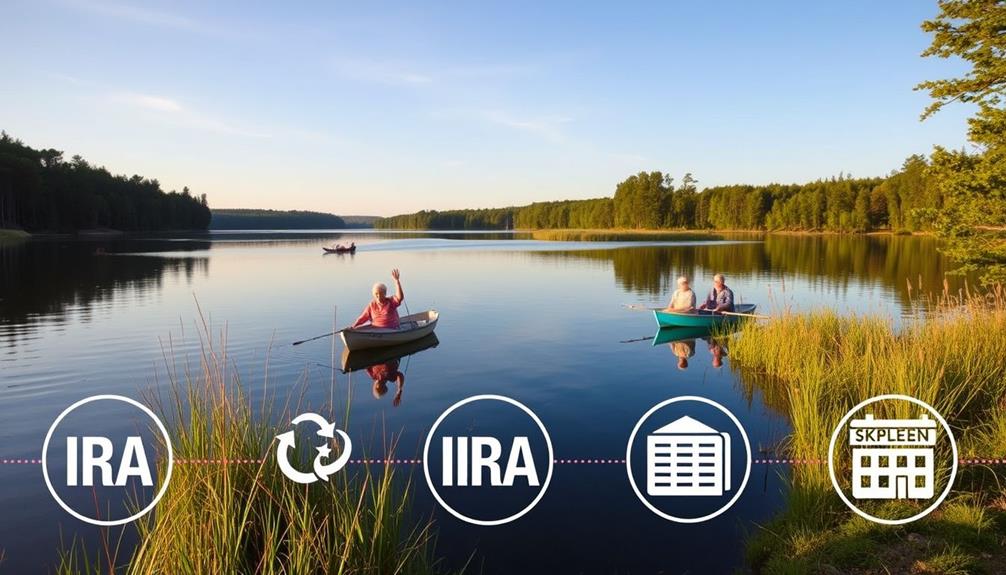When preparing for your retirement in Michigan, it’s important to consider incorporating your IRAs with state-specific benefits. The recent tax reform laws, which will be in effect starting 2023, provide opportunities for strategic planning to make the most of your pension benefits and IRA distributions. Understanding the tier structure based on your birth year can have a significant impact on your tax situation. It’s essential to complete Form 1099-R when reporting your retirement plan distributions to ensure compliance. Programs like the Michigan Secure Retirement Savings Program offer additional resources to help boost your savings. Continue to explore various strategies that align with your financial objectives.
Key Takeaways
- Understand the tax implications of IRA distributions in Michigan, which may qualify for retirement benefits subtraction under state law.
- Utilize the Michigan Pension Deduction Estimator to determine allowable subtractions for IRA distributions and maximize tax benefits.
- Contribute to IRAs annually, with limits of $6,500 or $7,500 for those aged 50 and older, for tax-advantaged retirement savings.
- Explore the Michigan Secure Retirement Savings Program, which complements IRAs by providing automatic enrollment and payroll deductions for private-sector employees.
- Keep in mind the tier structure for pension benefits, as it influences the eligibility for state tax subtractions on retirement income.
Overview of Retirement Planning

When it comes to retirement planning in Michigan, understanding the available options and regulations is fundamental. You need to familiarize yourself with various retirement savings programs, including traditional IRAs and state-sponsored retirement plans like the new Michigan Secure Retirement Savings Program. This program aims to help private-sector employees without employer-sponsored plans by offering an automatic enrollment IRA option, a significant benefit for building your retirement savings.
In addition to retirement accounts, it's essential to reflect on how your pension benefits will impact your financial future. Michigan has a tiered structure for pension benefit subtraction based on your birth date, which can affect your tax obligations. Those born before 1946 can subtract all qualifying pension benefits, while others have different eligibility criteria.
As you plan your retirement, make sure you're aware of the Form 1099-R, which is critical for reporting your retirement benefits for federal tax purposes. This form helps define the qualifying distributions necessary for claiming subtractions on your Michigan individual income tax returns.
Michigan Retirement Tax Changes

Michigan's new tax law brings exciting changes for retirees, offering more options for how you can handle your retirement benefits.
With the introduction of the Tier structure method and the phased-in restoration of pension subtractions, you'll want to understand how these updates affect your tax situation.
It's a good idea to consult with a tax preparer to make the most of these new opportunities.
New Tax Law Overview
The recent changes to retirement taxation in Michigan bring new opportunities for retirees to maximize their benefits. Under Public Act 4 of 2023, the state enhances options for retirement and pension benefits taxation, effective for the 2023 tax year and phased in over four years. This law aims to restore the pre-2012 pension subtraction for most taxpayers by 2026, offering significant advantages for your retirement income.
You can now choose among multiple calculation methods for pension subtraction, depending on your birth date and eligibility. Special provisions exist for public safety retirees, allowing full deductions of qualified distributions included in your adjusted gross income (AGI).
Here's a breakdown of how the new law impacts different taxpayers:
| Taxpayer Group | Pension Subtraction Eligibility | Calculation Method |
|---|---|---|
| General Retirees | Phased in by 2026 | Multiple options |
| Public Safety Retirees | Full deduction available | Specific rates applicable |
| Pre-1953 Retirees | Enhanced benefits | Tier structure options |
These changes mean you can better strategize your retirement benefits in light of your unique situation.
Retirement Benefit Subtractions
Maneuvering the new retirement benefit subtractions in Michigan can considerably impact your financial planning. With Public Act 4 of 2023, you can restore pre-2012 retirement and pension subtraction benefits, phased in over four years, culminating in 2026.
You'll need to classify your retirement income according to the Tier structure. If you were born before 1946, you can subtract all qualifying pension benefits, which may include distributions from your retirement savings plan.
For the 2022 tax year, you'll use the Tier structure calculation method. Starting in 2023, you'll have the flexibility to choose among several calculation methods each year, such as the Phase-In subtraction or the Qualified Fire, Police, and Corrections Retiree subtraction.
Tier Structure Method
Understanding the Tier Structure Method is key to steering through retirement tax changes in Michigan. This method categorizes retirees based on their birth dates into three tiers, directly affecting their eligibility for pension benefits and retirement tax benefits on state tax returns.
If you were born before 1946 (Tier 1), you can subtract all qualifying pension benefits from your taxable income. However, for those born between 1946 and 1952 (Tier 2), the rules tighten; generally, you won't qualify for pension subtraction in 2023.
Tier 3 includes taxpayers born after 1952, who typically don't qualify for any pension subtraction, indicating a phased approach to taxation.
Starting in tax year 2023, retirees can choose from multiple calculation methods, including Tier Structure Subtraction, Phase-In Subtraction, and Qualified Fire, Police, and Corrections Retiree Subtraction.
To navigate these options effectively, utilize the Michigan Pension Deduction Estimator, which helps you determine your allowable retirement benefit subtractions based on the Tier Structure Method. By understanding these nuances, you can optimize your retirement planning and minimize your tax burden.
Understanding Retirement Benefits

When planning for retirement in Michigan, it's essential to understand the different types of benefits available to you, like defined benefit pensions and IRA distributions.
You'll also want to take into account the tax implications that come with these benefits, especially since they can affect your Adjusted Gross Income.
Knowing how to navigate these aspects can help you make informed decisions for a secure financial future.
Retirement Benefit Types
Retirement benefits in Michigan encompass a variety of options that can significantly impact your financial future. These benefits include defined benefit pensions and IRA distributions, which are reported on Form 1099-R for federal tax purposes.
Understanding the different distribution types is essential, as they come with unique requirements. For instance, IRA distributions must generally occur after you reach age 59½, unless specific conditions like disability or death apply.
When you're evaluating your retirement options, it's important to reflect on whether you're eligible for a retirement plan that meets Michigan's criteria for state tax treatment. The state offers special tax benefits for qualifying distributions, as outlined in MCL 206.30(9),(10),(11).
Both employer plans and individual retirement accounts may provide opportunities for state tax subtractions if they adhere to the guidelines established by the Internal Revenue Code.
Working with financial advisors can help you navigate these complexities, ensuring that you make informed decisions about your retirement benefits. By understanding the various types of retirement plans and their specific requirements, you can better prepare for your financial future in Michigan.
Tax Implications Overview
Steering through the tax implications of retirement benefits in Michigan can be complex, but grasping the essentials is essential for maximizing your financial strategy. When you report your retirement distributions, including IRA distributions and pensions, you'll use Form 1099-R for federal tax purposes.
Your Adjusted Gross Income (AGI) plays a significant role in determining your Michigan individual income tax returns, encompassing all sources of income, including retirement benefits.
For 2023, new tax laws allow you to choose among multiple methods for calculating pension subtraction, which can affect your overall tax liability. It's important to understand the rules governing qualified distributions. These distributions must comply with the Internal Revenue Code (IRC) to qualify for favorable tax treatment on Michigan tax returns.
Additionally, the tier structure for retirement benefits impacts your eligibility depending on your birth date—those born before 1946 have different criteria than those born after.
Tax Treatment of Retirement Income

Understanding the tax treatment of retirement income in Michigan is vital for effective financial planning. The way your retirement distributions are taxed can greatly impact your Adjusted Gross Income (AGI) and overall financial health. Here are three key points to reflect on:
- Pension Benefits: If you were born before 1946, you can subtract all qualifying pension benefits. However, those born between 1946 and 1952 may not qualify for pension subtraction in 2023, with eligibility expanding through 2026.
- IRA Distributions: Taxpayers must adhere to specific subtraction guidelines under MCL 206.30 when reporting IRA distributions. Understanding how these affect your AGI is important.
- Social Security Considerations: Special tax considerations exist for retirees from government employment, allowing a deduction of up to $15,000 per qualifying spouse not covered by federal Social Security.
Navigating these aspects of retirement planning can help you maximize your tax benefits and guarantee your retirement income is efficiently managed.
Keep these factors in mind to enhance your financial strategy in Michigan.
Qualified Distribution Requirements

When planning for your retirement income in Michigan, it's critical to be aware of the qualified distribution requirements that can impact your tax benefits. To maximize your retirement subtraction and guarantee you're eligible for tax benefits, you'll need to understand specific criteria outlined by Michigan tax law and the Internal Revenue Code.
Here's a quick overview of the key distribution requirements:
| Distribution Type | Qualified? |
|---|---|
| Age 59½ or older | Yes |
| Disability | Yes |
| Death | Yes |
| Equal periodic payments | Yes |
Distributions from 401(k) and 403(b) plans must contain employee-only contributions to qualify for the retirement subtraction. Additionally, don't forget that 457 plan distributions are explicitly prohibited from qualifying for pension subtraction under Michigan tax law.
As you navigate your retirement planning, verify your withdrawals comply with these distribution requirements. Understanding these rules will help you protect your hard-earned savings and optimize your financial future.
Employer-Sponsored Retirement Plans

Employer-sponsored retirement plans play an essential role in helping you save for the future while taking advantage of tax benefits.
These plans, like 401(k) and 403(b) options, provide higher contribution limits compared to IRAs, making them an important tool in your retirement strategy.
In Michigan, the Michigan Secure Retirement Savings Program offers a safety net for employees without employer-sponsored plans.
It introduces features like:
- Automatic Enrollment: Eligible employees are automatically enrolled, simplifying the process of saving.
- Payroll Deduction: Contributions are deducted directly from your paycheck, making saving effortless.
- Contribution Rates: The program's board manages contribution rates, ensuring they align with your needs.
Employers must meet specific eligibility criteria to participate in state programs, such as not having offered a qualified retirement plan in the last two years and operating for at least 730 days.
Compliance is essential, as penalties for non-compliance can range from $20 to $500 per employee.
Individual Retirement Accounts

Utilizing Individual Retirement Accounts (IRAs) can greatly enhance your retirement savings strategy. These tax-advantaged accounts allow you to set aside money for your future, with contributions potentially being tax-deductible based on your income and filing status.
For Michigan retirees, understanding IRA distributions is vital, as they can qualify for retirement benefits subtraction under specific guidelines in MCL 206.30, provided you meet age and distribution criteria.
One of the key advantages of IRAs is that your retirement funds grow tax-deferred until you decide to withdraw them. This tax-deferred growth can lead to a considerably larger accumulation compared to taxable accounts.
For the 2024 tax year, keep in mind that contributions to traditional IRAs are capped at $6,500 annually, or $7,500 if you're 50 or older.
In Michigan, the 2023 tax year even lets retirees choose from various calculation methods for allowable retirement subtractions, including those from your IRA distributions.
Form 1099-R and Reporting

How do you navigate the complexities of Form 1099-R? This form is vital for reporting distributions from retirement plans and IRA distributions, and it plays a significant role in your retirement planning. Understanding it can help you maximize your retirement benefit subtraction on Michigan tax returns.
Here are three key points to take into account:
- Distribution Codes: The form includes specific codes that indicate the type of distribution. Make certain to check these codes to confirm eligibility for the retirement benefit subtraction.
- Qualifying Distribution Requirements: Verify that the reported amounts on Form 1099-R meet Michigan's qualifying distribution requirements. This is essential for receiving any tax benefits.
- Adjusted Gross Income Impact: Remember that the gross income reported on Form 1099-R contributes to your Adjusted Gross Income (AGI), which is the basis for calculating your Michigan individual income tax.
Resources for Retirement Planning

Retirement planning in Michigan is supported by a variety of resources designed to help you make informed decisions. One key resource is the Michigan Secure Retirement Savings Program, which automatically enrolls employees without employer-sponsored plans. This program gives you the flexibility to set and adjust your contribution rates whenever necessary.
It's managed by the Secure Retirement Savings Board, guaranteeing compliance with state regulations. Additionally, considering options like a Gold IRA can enhance your retirement portfolio by providing protection against inflation and market downturns, which is vital in today's economy. For those looking to diversify their retirement savings, IRA Rollover to Gold offers potential tax advantages and higher returns over the long term.
If your employer hasn't offered a qualified retirement plan in the last 730 days, they might be eligible to participate, helping you maximize your savings potential. Additionally, utilizing MI-1040 tax forms can guide you in understanding tax implications related to your retirement contributions.
Another valuable tool is the 2023 Pension Deduction Estimator, which allows you to calculate your allowable retirement benefits and deductions. By strategically combining these resources with your IRAs and any employer match options, you can create a robust retirement strategy.
It's important to stay informed about Michigan's retirement programs to make sure you're on the right track toward a secure financial future.
Frequently Asked Questions
Are IRA Distributions Taxable in the State of Michigan?
Yes, IRA distributions are taxable in Michigan. You'll need to report them on your state tax return. For accurate filing, consider consulting a tax preparer to navigate any specific rules that apply to your situation.
What Is the New Tax Law for Seniors in Michigan?
The new tax law for seniors in Michigan allows you to fully subtract qualifying pension benefits if born before 1946. You'll also find multiple calculation methods to optimize your retirement tax benefits starting in 2023.
Does Michigan Tax Pensions From Other States?
Oh, you thought escaping taxes was easy? In Michigan, pensions from other states are indeed taxed, but don't worry! You might qualify for deductions based on your birth year and specific retirement benefits.
Does the State of Michigan Offer Pension Plans?
No, Michigan doesn't offer state-sponsored pension plans. Instead, it has the Secure Retirement Savings Program, which helps private-sector employees save for retirement through automatic payroll deduction IRAs, ensuring everyone has access to retirement savings options.
Conclusion
In managing your retirement planning in Michigan, think of your finances as a garden. You need to cultivate it carefully, integrating IRAs with state-specific benefits to guarantee a bountiful harvest. Stay informed about tax changes and distribution requirements to help your investments thrive. By understanding the landscape of retirement benefits and taking advantage of employer-sponsored plans, you can create a flourishing future. So, get ready to plant the seeds today for a secure and prosperous tomorrow.
Helen brings a wealth of experience in investment strategy and a deep passion for helping individuals achieve their retirement goals. With a keen understanding of market dynamics, Helen has been instrumental in shaping the vision and direction of Gold IRA Markets. She specializes in creating innovative solutions that align with our clients’ long-term investment objectives.










